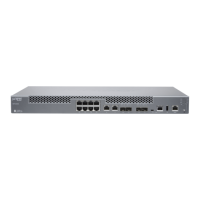3. Configure the Packet Forwarding Engine’s LAN-side front panel port and add it to
the LAN-side VLAN.
The LAN-side port is typically an access port, but could be a trunk port if appropriate.
user@jcp# set interfaces ge-0/0/2.0 family ethernet-switching vlan members vlan1
4. Configure the Packet Forwarding Engine’s LAN-side internal-facing interface as a
trunk port and add it to the LAN-side VLAN.
The internal-facing interfaces are typically trunk ports, as they must support traffic
from multiple front panel ports and VLANs.
user@jcp# set interfaces sxe-0/0/0.0 family ethernet-switching interface-mode trunk
user@jcp# set interfaces sxe-0/0/0.0 family ethernet-switching vlan members vlan1
5. Configure a VLAN for the WAN-side interfaces.
user@jcp# set vlans vlan2 vlan-id 1177
6. Configure the Packet Forwarding Engine’s WAN-side front panel port as a trunk
port and add it to the WAN-side VLAN.
The WAN-side front panel port is typically a trunk port, as it might be required to
support multiple VLANs.
user@jcp# set interfaces xe-0/0/12.0 family ethernet-switching interface-mode trunk
user@jcp# set interfaces xe-0/0/12.0 family ethernet-switching vlan members vlan2
7. Configure the Packet Forwarding Engine’s WAN-side internal-facing interface as a
trunk port and add it to the WAN-side VLAN.
The internal-facing interfaces are typically trunk ports, as they must support traffic
from multiple front panel ports and VLANs.
user@jcp# set interfaces sxe-0/0/0.0 family ethernet-switching vlan members vlan2
8. Commit the configuration and return to the JDM.
user@jcp# commit and-quit
user@jcp> exit
user@jdm>
Results From configuration mode, check the results of your configuration by entering the following
show commands:
[edit]
Copyright © 2017, Juniper Networks, Inc.158
JDM User Guide for NFX250 Network Services Platform

